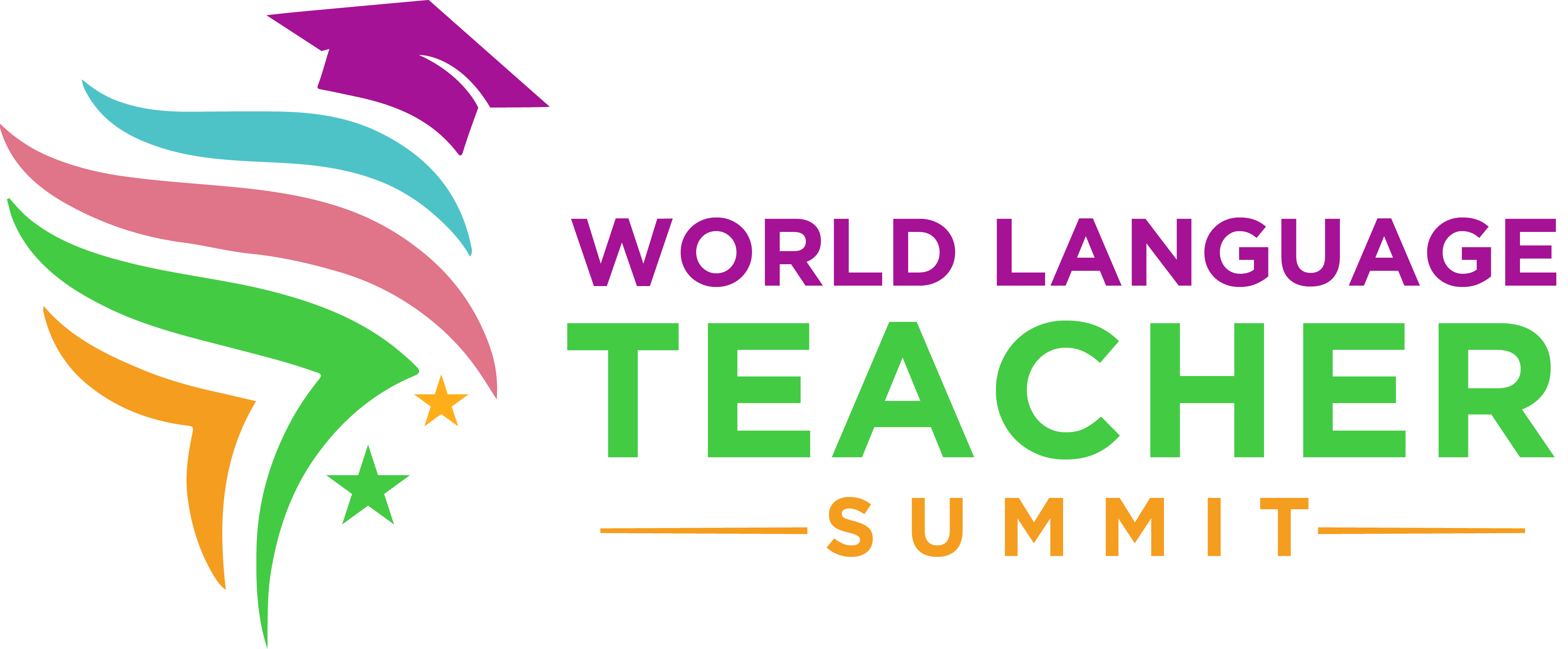the 2019 world language teacher summit EXPERT MASTERCLASS SESSIONS
The 2019 World Language Teacher Summit All-Access Pass gathered this hand picked lineup of world-language teaching experts in one place sharing clear strategies that work today. Our expert mentors will tell you how you can implement the very same strategies they use to start seeing amazing results, quickly!
▼Click to Open/Close
BUILDING CLASSROOM COMMUNITY (9 SESSIONS)
In these sessions you will learn about strategies and routines that inspire and engage your students. From curiosity to community and from pure classroom management strategies to day-1 tips, take time to reflect on how you draw students into language learning. Feel like community-building is a quick win for you? Listen about infusing more reflection into your lesson plans or modifying the same lesson to multiple levels.

Inspiring Curiosity in The World Language Class
BY MEGAN SMITH
To encourage more communication and engagement in the classroom, Megan shares several ways teachers can spark curiosity in their students. Modeling good questions, intriguing resources, and visually appealing handouts, this presentation offers examples with art, music, and housing that motivates students to dig deeper and talk longer.

Mindfulness in the World Language Classroom
BY LYNN RAMSSON
In this presentation, veteran teacher Lynn Ramsson offers a definition of mindfulness while explaining the benefits of incorporating notions of mindfulness into teaching and learning world languages. She suggests specific strategies that can make a world language classroom more mindful while pointing out Comprehensible Input methods that are particularly compatible with mindfulness.

Creating Community in The World Language Classroom
BY DIEGO OJEDA
Diego speaks from his three decades of experience about how creating intentional community prepares students to be citizens in the world. As you focus on authenticity in class, you engage students in learning language and participating in your class.

Empower Students: Give Them Words and A Mirror
BY BECKIE BRAY RANKIN
Beckie discusses the different ways that reflective thinking can benefit students and improve their learning experience in this presentation while acknowledging that a change in thinking can be challenging. She explains how to make this change easier for everyone involved, providing encouragement and anecdotal evidence from her own time in the classroom.

Don't Start with The Syllabus: Building Relationships in L2
BY NISSA QUILL
Nissa challenges teachers to rethink their first day with students to avoid jumping into the rules in English. Start with some community-building communicative activities like card talk or kid grid.

A Day in The Elementary CI Classroom: Routines and Strategies
BY VALENTINA CORREA
Valentina shares some of her tried and true routines, activities, and games that keep her elementary students engaged in her class. From animal-based rules to creaking door sound effects, this presentation offers fun ideas for any level.

Culturally Responsive Teaching in the World Language Classroom
BY KELSEY MCGRATH
Kelsey elaborates on what is culturally responsive teaching by first discussing what it is not. The presentation aims for educators to be able to explain culturally responsive teaching and reflect on their practice & then implement several culturally responsive teaching strategies. Kelsey then shares some cultural learning strategies and best practices and how she uses them in her class.


Building Community through Self-Assessment and Reflection
BY TIFFANY DALTON LÓPEZ & KIMBERLY CLELA DAVIS
Kimberly and Tiffany share their experiences of encouraging student reflection in the classroom to build a community with their students. They emphasize the fact that reflection is a skill that needs to be taught and the importance of scaffolding the process in order to maximize its potential. They also suggest a practical strategy, together with concrete examples, for implementing this approach in the classroom.

EFA: Edutaining Formative Assessment
BY GLENN CAKE
Glenn Cake demonstrates how to use web-based games that are engaging and practical for students in the class. He shows how he uses these games in his class.
LEVERAGING THE INTERPRETIVE MODE (8 SESSIONS)
Can I still use the textbook as a source of language input? When is too early to infuse literacy strategies with elementary learners? How do I ensure my learners understand what they are hearing? Research continues to highlight the importance of interpreting in language acquisition, so join our presenters to envision best practices of input: books, movies, songs, tech tools, and more!

How to Teach with Novels
BY HÉLÈNE COLINET
Hélène shares with the audience her passion for books and shows how she was able to incorporate novels in her teaching practice. She also provides some information about the role of Comprehensible Input in the development of language competence and literacy. Finally, she describes a large number of varied activities that can be done before, during, and after reading novels in class.

Teaching the Textbook Through A CI Lens
BY KAITLIN LEPPERT
Kaitlin has successfully transitioned from teaching with a textbook to delivering targeted and non-targeted comprehensible input. She first explains how to make your language more accessible to students. She then takes you through an entire textbook unit of study to show you how each activity can be adapted to fit her key criteria for delivering student-centered, engaging, comprehensible input.

Try Some CI: Activities to Incorporate Comprehensible Input
BY ALLISON WIENHOLD
Allison Weinhold is a one-woman world language department, and in this presentation, she talks about her transition from teaching according to traditional methods to a CI approach in a desk-free classroom. She offers teachers several crowd-pleasing CI activities to use immediately as well as a list of resources.

The Importance of Slow in The Comprehensible Input Classroom
BY MILA GARNER
French teacher and CI enthusiast Mila Gardner explains why speaking slowly is an essential skill for world language teachers who want to be as comprehensible as possible for their students. She describes her own experience as a classroom teacher in detail, and she provides helpful tips and a thorough explanation of benefits in this presentation. Mila includes a classroom demonstration of her techniques and her slow approach to teaching with CI so teachers will be able to learn from her example.

CI with Non-Readers
BY ELISABETH ALVARADO
Elisabeth discusses how input can be comprehensible for learners who can’t yet read. Strategies for selecting rich input, keeping it comprehensible, and engaging their attention allow teachers to think critically about what language they give students.

The Switch: Switching from Teaching for Learning to Teaching for Acquisition
BY ALBERT FERNÁNDEZ
Albert Fernández, also known as Señor Fernie, speaks about making the switch from textbook-driven language teaching to a proficiency focus. He emphasizes the importance of setting intentional goals for your own teaching as well as the benefits of teaching for acquisition.

Comprehensible Input Drawing for Non-Artists
BY BRYAN WHITNEY
Brian Whitney encourages teachers, even those with limited artistic ability, to make use of simple drawings in the classroom to help engage students’ attention and provide visual support during extended listening activities. He provides teachers with step-by-step instructions for presenting both a fictional story (‘The Tortoise and the Eagle’) and a real-life scientific process (‘The Food Chain’) – and then demonstrates how to present them in the classroom.

Bringing Sustained Silent Reading (SSR) to World Languages
BY BRETT CHONKO
Brian Whitney encourages teachers, even those with limited artistic ability, to make use of simple drawings in the classroom to help engage students’ attention and provide visual support during extended listening activities. He provides teachers with step-by-step instructions for presenting both a fictional story (‘The Tortoise and the Eagle’) and a real-life scientific process (‘The Food Chain’) – and then demonstrates how to present them in the classroom.
BALANCING A TEACHER'S LIFE (7 SESSIONS)
High Leverage Strategies claim to offer the most learning for the least prep, but late nights and early mornings are not strangers to teachers. Simplify is the summary of this summit theme. When structures such as lesson plans, routines, positive groupings, and strategic grading are in place, you have more time for being you outside of your classroom, which in turn allows more energy inside your classroom. It's a self-energizing circle. Allow who you are to be part of how you teach as you work towards balance. Recharge!

Setting Lesson and Unit Learning Outcomes
BY TINA HARGADEN
As we transition from traditional textbook and grammar-heavy teaching to a more student-centered communicative approach, sometimes it feels challenging to fill our daily lesson plans. Tina gives some suggestions based on the ACTFL Can Do Statements and Performance Descriptors for what students are able to do at each level and a sample learning progression model.

The Peaceful Teacher: A Guide to Teaching Mindfully (While Maintaining Your Sanity!)
BY JASON BOND
Jason shares his experience learning about meditation and how it saved his career and his sanity. In this presentation, he shares with the audience the techniques that he has used. Bond’s presentation serves as a guided meditation for educators. From this presentation, teachers will gain insight into the use of mindfulness in order to reduce burnout, an understanding of the tall mountain meditation techniques and a set of mindfulness activities that they can use in their daily teaching lives.

Classroom Management, CI, And Proficiency Together: A High-Leverage Trifecta
BY MEREDITH WHITE
Meredith White has tried and true ideas to make your classroom work more smoothly. She shares tips for the implementation of classroom jobs and discusses its impact on behaviors, investment, and classroom management. She also shares her daily and weekly instructional routines and how she and her students have benefited from the built-in backup plans those routines provide.

Routines for The World Language Classroom
BY ASHLEY MIKKELSEN
Ashley describes routine activities she uses in her classroom to engage students in her themes. Some tasks repeat daily and others throughout the week or unit. Learn about how she structures these activities to see what may work for you.

Effective and Efficient Grading Practices for Language Acquisition
BY JODI STOKDYK
Jodi lays out ways to increase the effectiveness of grading practices without spending more time on the process, while emphasizing communication through all modes. By thoughtfully selecting your assessments, the level of feedback best for students, and your reason for grading, decrease your take-home work load!

Grouping Students: Intentionally, Easily, And Fairly
BY BENJAMIN BRADSHAW
Quick assessment dipsticks students on a particular task or activity, which allows grouping that is fair and efficient. Benjamin explains how you can use groups based on ability and random groups to motivate students and help them learn best.

Foldables are the Key to No-Prep Sanity
BY BERTHA DELGADILLO
Bertha Delgadillo explains what she means by ‘No-Prep Foldables’ and clarifies the benefits they offer to both students and teachers. She also shares practical examples of a variety of different types of foldables, together with suggestions for integrating them into the classroom and tips for setting them up successfully.
PLANNING COMMUNICATIVE STRATEGIES (9 SESSIONS + 1 BONUS)
Harness the energy of your students into fun, thematic interpersonal activities. Combining child development psychology with technology and scaffolds like Anchor Charts allow for real life-like situations where students can grow their proficiency level. Whether through planned games, learning centers, or paired discussions, encourage your students to dialogue in meaningful conversations. Let’s talk!

Engaging Students in The Interpersonal Mode
BY LISA SHEPARD
Lisa offers teachers a thorough explanation of the interpersonal mode in this informative and well-organized presentation. As well, Lisa offers teachers a multitude of activities and ideas for lessons that encourage students to interact and to communicate with each other.

Beyond Language Exposure: Proficiency in Elementary and Middle School
BY JOSHUA CABRAL
Joshua Cabral links language proficiency goals with important child development principles in this informative presentation for elementary and middle school world language teachers. He offers teachers an in-depth approach to interactive teaching methods that promote language proficiency and foster a deeper understanding of global cultures in students.

Let's Give Them Something to Chat About
BY BETHANIE DREW
Bethanie offers some insight into why using chat mats as a scaffolding resource for students allows them to practice higher level production without memorizing. With four different examples, this presentation walks you through activities to use with chat mats about descriptions, opinions, and weekends.


The Making of the #mfltwitterati Podcast: Tech Tips for Engagement
BY NOAH GEISEL & JOE DALE
After describing the nature of their new podcast “MFLTWITTERATI”, Noah and Joe walk through several lesser-known techie resources they have shared in various episodes, to get your students engaged in learning.

Get 'Em Speaking: Activities and Strategies to Promote Speaking Proficiency
BY SHERI PLATH
Sheri Plath, Oral Proficiency Interview trained instructor, shares how and why she gets kids speaking the target language for a goal of 50% of every class period. She shares ways to support emerging speakers and how to create an environment of student buy-in. She recommends ways to keep students - and teachers - accountable to use target language in level-appropriate tasks that could be used with any topic!

BONUS SESSION: Using Centers To Get 'Em Speaking
BY SHERI PLATH
Sheri Plath shares how to improve speaking skills by using centers. She gives ideas for speaking, listening, writing, and reading centers and makes recommendations that will keep your groups moving through the centers smoothly.

Student-Centered & Communicative Learning
BY FADI ABUGHOUSH
Fadi describes successful games and activities he uses with his students, in which they speak the target language, and then includes in-class demos for you to see.

World Language Strategies Through Intercultural Lenses
BY TRACY E. RUCKER
Tracy Rucker gives fellow teachers a thorough explanation of Intercultural Language Teaching Strategies and offers a valuable insight into the Iceberg Model of Surface and Deep Culture. In addition, he explains in detail the methods that he personally uses in his world languages classes and shares several global awareness activities that teachers can use in their classrooms in order to foster intercultural learning.


Using Comprehensible Input Strategies to Support ACTFL Core Practices
BY ERIN NIENAS & ZOE WITZELING
Erin and Zoe reflect on the importance of the connection between Comprehensible Input and ACTFL Core Practices. They clarify the first three ACTFL Core Practices, outline their benefits and offer a wide variety of activities and online resources which focus on using comprehensible input, authentic resources and oral interpersonal communication tasks in the language classroom.
TEACHING IN SPECIFIC CONTEXTS (10 SESSIONS)
These sessions are for all of us who have a “special class”. Be it large, full of young learners, mixed with different language abilities, or too many bodies for your small room, there is a presenter who has struggled like you! Maybe your place to grow is more theoretical: integrating culture in a more meaningful way, or bringing in more target language, or motivating reluctant learners. Tech and teacher toolbox ideas will inspire you for the rest of your year.

Empowering Special Needs Students
BY KRISTEN WOLF
Kristen provides various strategies that can help teachers create an inclusive learning environment. The goal is to help special-needs learners perform tasks as much as other learners.

Intercultural Competence with Younger Learners
BY DORIE CONLON PERUGINI
Dorie makes a case for the critical need to intentionally teach intercultural competencies at any language learner level. After defining intercultural competencies and exploring Byram’s ICC Model, she encourages us to integrate these competencies into our curriculum.

Motivating Reluctant Language Learners
BY EMILIE DEL RISCO
Emilie breaks down reluctant learners into three categories that lead into ideas to motivate them. With tips from planning to implementing, every teacher can find a way to relate to students and engage them in learning.

No, It’s Not Mexican Halloween: Holidays and Cultural Parallels
BY STEPHANIE MADISON SCHENCK
Teaching traditions as part of your culturally steeped unit is engaging to students, but if we teach only the tip of the iceberg of culture, we promulgate misconceptions. Stephanie shares some fun twists to holidays we typically teach to ensure we value representation and nuance.

How to Manage Large Classes
BY RACHEL LUCAS
Large and energy-filled classroom can challenge a teacher’s sanity! Using tech tools and organizational strategies, Rachel Lucas shares how she successfully manages classrooms with up to 53 students.

A Framework for Effective Classroom Management in The Target Language
BY JULIE SPENO
Julie goes through step-by-step what it looks like to create, demonstrate, and reinforce expectations and routines in the (elementary) classroom. By being consistent and concise, we offer students the best chance at being successful and feeling safe in our room.

MurDEring Motivation: Disengagement Processes in Foreign Language Learning
BY DR. MARÍA DEL CARMEN MÉNDEZ SANTOS
Dr. María Santos presents the failures of Foreign Language programs as well as solutions to overcome the challenges that transpire during lessons in connection to demotivation. She presents how language policies are not working as expected causing the high level of language learning failure worldwide.

Aligning Communication Skills from Level 1 to Advanced Placement
BY THEA ROESSLER
Thea gives details about the proficiency levels that language learners come across and how the skills on each level crisscross to what learners have to do. She explains how the awareness of the learners’ level help in knowing how to align kids’ work in their learning and their efforts towards being successful in level 4 and AP. Example activities are provided in the presentation as well as suggestions as to what language teachers could do moving forward in order for them to utilize the goals in helping the learners achieve a certain level.

Move Your Department Towards Effective Practices
BY ERIN NIENAS
Spanish teacher Erin Nienas shares her experience as a Spanish Teacher and provides fellow teachers valuable advise on how to incorporate effective practices in their teaching. In the first part of the presentation, Erin focuses on the strategies teachers can use to work together with their departments in order to incorporate effective teaching practices. The second part of the presentation is devoted to the work that teachers can do in their own classrooms in order to promote said effective practices.

Pre-AP Strategies in the World Language Classroom
BY LISA PODBILSKI
Lisa Podbilski shares strategies on how to help students self-advocate in all the areas of language learning. Alongside these strategies are her personal experiences which she deemed successful and resources which can be modified and used as tools to help empower students have control over their learning. Furthermore, she elaborates on building towards AP starting from lower level and all the scaffolds teachers need to provide to build up the necessary skills in each level.
Get Access To 43 World-Class Expert Masterclass Sessions Plus $999 In Exclusive Bonuses... For Only $1,329 $99

Get Access To 43 World-Class Expert Masterclass Sessions Plus $999 In Exclusive Bonuses... For Only $1,329 $99

© 2025 World Language Teacher Summit All rights reserved. Curated by Speaking Latino and Language Babel.
